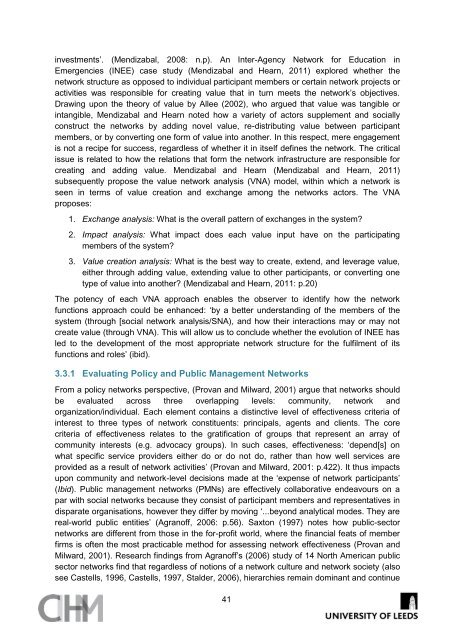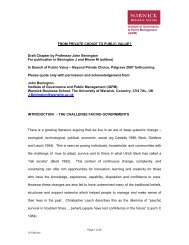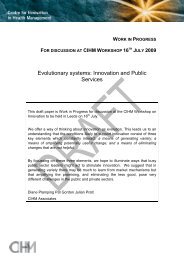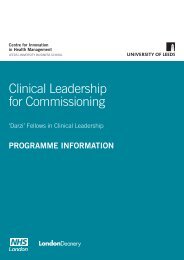investments’. (Mendizabal, 2008: n.p). An Inter-Agency Network <strong>for</strong> Education inEmergencies (INEE) case study (Mendizabal and Hearn, 2011) explored whe<strong>the</strong>r <strong>the</strong>network structure as opposed to individual participant members or certain network projects oractivities was responsible <strong>for</strong> creating value that in turn meets <strong>the</strong> network’s objectives.Drawing upon <strong>the</strong> <strong>the</strong>ory of value by Allee (2002), who argued that value was tangible orintangible, Mendizabal and Hearn noted how a variety of actors supplement and sociallyconstruct <strong>the</strong> networks by adding novel value, re-distributing value between participantmembers, or by converting one <strong>for</strong>m of value into ano<strong>the</strong>r. In this respect, mere engagementis not a recipe <strong>for</strong> success, regardless of whe<strong>the</strong>r it in itself defines <strong>the</strong> network. The criticalissue is related to how <strong>the</strong> relations that <strong>for</strong>m <strong>the</strong> network infrastructure are responsible <strong>for</strong>creating and adding value. Mendizabal and Hearn (Mendizabal and Hearn, 2011)subsequently propose <strong>the</strong> value network analysis (VNA) model, within which a network isseen in terms of value creation and exchange among <strong>the</strong> networks actors. The VNAproposes:1. Exchange analysis: What is <strong>the</strong> overall pattern of exchanges in <strong>the</strong> system?2. Impact analysis: What impact does each value input have on <strong>the</strong> participatingmembers of <strong>the</strong> system?3. Value creation analysis: What is <strong>the</strong> best way to create, extend, and leverage value,ei<strong>the</strong>r through adding value, extending value to o<strong>the</strong>r participants, or converting onetype of value into ano<strong>the</strong>r? (Mendizabal and Hearn, 2011: p.20)The potency of each VNA approach enables <strong>the</strong> observer to identify how <strong>the</strong> networkfunctions approach could be enhanced: ‘by a better understanding of <strong>the</strong> members of <strong>the</strong>system (through [social network analysis/SNA), and how <strong>the</strong>ir interactions may or may notcreate value (through VNA). This will allow us to conclude whe<strong>the</strong>r <strong>the</strong> evolution of INEE hasled to <strong>the</strong> development of <strong>the</strong> most appropriate network structure <strong>for</strong> <strong>the</strong> fulfilment of itsfunctions and roles’ (ibid).3.3.1 Evaluating Policy and Public Management <strong>Networks</strong>From a policy networks perspective, (Provan and Milward, 2001) argue that networks shouldbe evaluated across three overlapping levels: community, network andorganization/individual. Each element contains a distinctive level of effectiveness criteria ofinterest to three types of network constituents: principals, agents and clients. The corecriteria of effectiveness relates to <strong>the</strong> gratification of groups that represent an array ofcommunity interests (e.g. advocacy groups). In such cases, effectiveness: ‘depend[s] onwhat specific service providers ei<strong>the</strong>r do or do not do, ra<strong>the</strong>r than how well services areprovided as a result of network activities’ (Provan and Milward, 2001: p.422). It thus impactsupon community and network-level decisions made at <strong>the</strong> ‘expense of network participants’(Ibid). Public management networks (PMNs) are effectively collaborative endeavours on apar with social networks because <strong>the</strong>y consist of participant members and representatives indisparate organisations, however <strong>the</strong>y differ by moving ‘...beyond analytical modes. They arereal-world public entities’ (Agranoff, 2006: p.56). Saxton (1997) notes how public-sectornetworks are different from those in <strong>the</strong> <strong>for</strong>-profit world, where <strong>the</strong> financial feats of memberfirms is often <strong>the</strong> most practicable method <strong>for</strong> assessing network effectiveness (Provan andMilward, 2001). Research findings from Agranoff’s (2006) study of 14 North American publicsector networks find that regardless of notions of a network culture and network society (alsosee Castells, 1996, Castells, 1997, Stalder, 2006), hierarchies remain dominant and continue41
to meet <strong>the</strong> legal and policy based functions of government. Agranoff (2006) highlighted <strong>the</strong>diversity of public sector networks, which are rarely alike, but differ through what <strong>the</strong>y do andlevels of power and command (some have much less powers than o<strong>the</strong>rs).In essence, all networks should be voluntary entities, however PHNs are compulsory (Abbottand Killoran, 2005). The Teaching Public <strong>Health</strong> Network (TPHN) initiative, a unique regionalnetwork model funded by <strong>the</strong> DoH, was developed in response to <strong>the</strong> call <strong>for</strong> enhancedaccess to (and provision of) public health focused education and training, and as amechanism <strong>for</strong> developing specific work on a broad curriculum encompassing highereducation, services and voluntary/third sectors (Sim, 2007). However <strong>the</strong> construction of aregional network was an immensely complex phenomenon which had not been undertakenbe<strong>for</strong>e (ibid).3.3.2 Evaluating Managed <strong>Networks</strong>NHS managed networks have existed <strong>for</strong> almost a decade but are in urgent need <strong>for</strong> re<strong>for</strong>m(Addicott et al., 2007). Managed <strong>Networks</strong> <strong>the</strong>ory is based on <strong>the</strong> concept of hierarchicalnetworks that emerged from beyond <strong>the</strong> health sector remit. Harris (2005) noted howmanaged networks are based on hub and spoke service arrangements, and <strong>the</strong>ir aim is tomaintain a high standard of service or if delivery of change is needed. They are based on<strong>for</strong>mal collaborations/partnerships with instilled accountability and governance arrangements(Rosen et al., 2011). Managed networks undertake a number of strategic functions includingcommissioning, implementing service-level agreements (SLAs) and/or contracts, and oftenhave <strong>the</strong> power to agree service re-design/reconfigurations. They also have delegatedfunctions from <strong>the</strong>ir respective host organisations and possess supra-organisationaldecision-making powers and strategic roles in service development. Managed networksusually have specific external objectives, and also <strong>the</strong> power to regulate (Harris, 2005,Addicott et al., 2007, Guthrie et al., 2010).Most collaborations and clinical networks in <strong>the</strong> UK follow <strong>the</strong> managed approach whichentail <strong>for</strong>mal partnerships driven by professionals; constructed with aim to change service (or<strong>for</strong> network interventions to improve health care).The managed network in North Lanarkshirefaces significant challenges to successful integration through variations in national policy,socio-technical problems in developing a supportive ICT system and inconsistent progressacross different locales and care groups, thus highlighting <strong>the</strong> need (dependency) on localleadership (Rosen et al., 2011). The North East Lincolnshire Care Trust Plus provide onecentral face (senior leader) to <strong>the</strong> network who manages <strong>the</strong> complex care provided bydisparate people and teams (Smith, 2010). Section 2.1.1 described how <strong>the</strong> NorthLanarkshire partnership (collaboration between health and social care (H&SC) staff) hadfused governance arrangements which outlined <strong>the</strong> responsibilities and accountabilities of<strong>the</strong> respective H&SC teams (some were integrated and o<strong>the</strong>rs entailed workingcollaboratively) at different network levels across localities and care groups (Rosen et al.,2011). Drawing upon Dickinson and o<strong>the</strong>rs, (2007) and Glendenning, (2003), Rosen notedhow ‘Normative integrative processes were crucial <strong>for</strong> integration across partnerships andnetworks, and particularly across health and social care, as underlined by [North Lanarkshirepartnership] [who] had to devote a lot of ongoing ef<strong>for</strong>t to achieve this’ (Ibid: p.36).42
- Page 1 and 2: Centre for Innovation in Health Man
- Page 3 and 4: 2.4 Agency Networks, Policy Network
- Page 5 and 6: ‘Networks can take many forms to
- Page 7 and 8: of the parts.based uponintegrity.Ho
- Page 9 and 10: Why theyfailIf it struggles toachie
- Page 11 and 12: Table 2: Examples of NetworksManage
- Page 13 and 14: 1.1.3 The scoping methodologyA brai
- Page 15 and 16: pathways, managed clinical networks
- Page 17 and 18: in terms of a shared vision, common
- Page 19 and 20: Rangachari (Rangachari, 2008) took
- Page 21 and 22: Turrini et al (2009) also raise fou
- Page 23 and 24: Trying things out: just taking some
- Page 25 and 26: Success is attributed/dependant on
- Page 27 and 28: 2.2 Developmental NetworksCharacter
- Page 29 and 30: transaction costs. Also: ‘...the
- Page 31 and 32: The authors acknowledge that the mo
- Page 33 and 34: Research has explored regional clus
- Page 35 and 36: Networks are essentially a form of
- Page 37 and 38: significant social bonds and joint
- Page 39 and 40: 3 Network Evaluation and Future of
- Page 41: contractual relationships; the arra
- Page 45 and 46: Sectors Networks (PSNs) are underst
- Page 47 and 48: coordinated manner, unconstrained b
- Page 49 and 50: Research has shown that there is no
- Page 51 and 52: perhaps are used as a way to avoid
- Page 53 and 54: attempted to determine (section 1.2
- Page 55 and 56: Leadership, 2, 147-163.BOURDIEU, P.
- Page 57 and 58: DOUGHERTY, T. W., CHEUNG, Y. H. & F
- Page 59 and 60: other social media are reshaping he
- Page 61 and 62: NHS SCOTLAND. 2010. Review of nine
- Page 63 and 64: mental patients in a Manhattan SRO
- Page 65 and 66: AppendixPrinciples of engagement (M
- Page 67 and 68: NHS Networks: The document (NHS NET
- Page 69 and 70: iPrinciples of engagement (MENDIZAB
- Page 71 and 72: • frequently updated - not live,
















